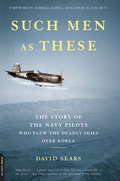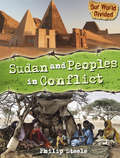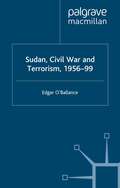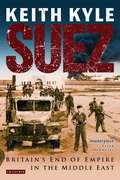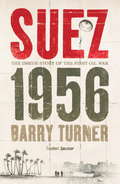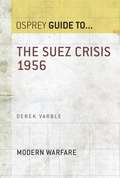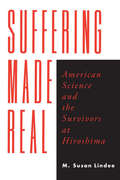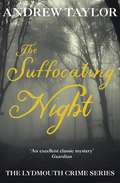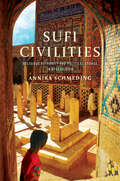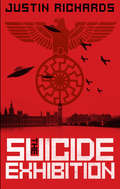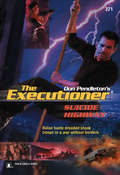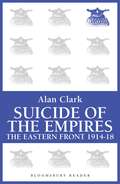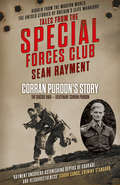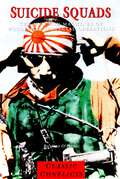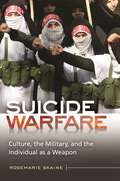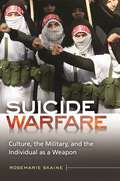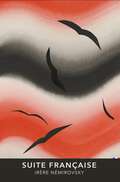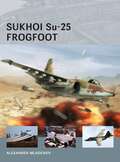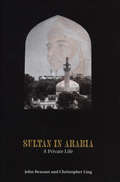- Table View
- List View
Such Men as These: The Story of the Navy Pilots Who Flew the Deadly Skies over Korea
by David SearsIn 1951, James Michener went to Korea to report on a little known aspect of America's stalemated war: navy aviators. His research inspired novel about these pilots became an overnight bestseller and, perhaps, the most widely read book ever written about aerial combat. Using Michener's notes, author David Sears tracked down the actual pilots to tell their riveting, true-life stories. From the icy, windswept decks of aircraft carriers, they penetrated treacherous mountain terrain to strike heavily defended dams, bridges, and tunnels, where well entrenched Communist anti-aircraft gunners waited to shoot them down. Many of these men became air combat legends, and one, Neil Armstrong, the first astronaut to walk on the moon.Such Men As These brims with action-packed accounts of combat and unforgettable portraits of the pilots whose skill and sacrifice made epic history.
Sudan and Peoples in Conflict: Sudan And Peoples In Conflict (Our World Divided)
by Philip SteeleThe background, history and key events of conflicts are presented. Different opinions, including views found in the media, are explored alongside factual accounts of events. Readers are encouraged to think about their own views and discuss controversial topics.
Sudan, Civil War and Terrorism, 1956-99
by E. O'BallanceSudan, the largest country in Africa, became independent in 1956, to find it had a foot in both the Arab Muslim and the Black African camps. Almost immediately a sixteen year civil war began, ending with autonomy for the South, which devolved into chaos. A second southern revolution broke out in 1983 when the government introduced the Sharia law, which is still in progress, the impasse halted only by an uneasy cease-fire. Central governments have been mainly military dictatorships, plagued by plots, quarrels with adjacent countries, and involvement in international terrorism.
Suez: Britain's End of Empire in the Middle East
by Keith KyleOn 26 July 1956, the British Empire received a blow from which it would never recover. On this day, Egypt's President Gamal Abdul Nasser nationalized the Suez Canal Company, one of the gems of Britain's imperial portfolio. It was to be a fateful day for the empire.The British government led by Anthony Eden considered this to be a test case of Britain's standing as a world power - the prestige of the empire was already in decline and one last stand was essential. Britain, together with France and Israel, became involved in the instigation of the Suez campaign which ended with the USA becoming the leading power in the United Nations, its opposition to the campaign having been decisive in forcing ignominious withdrawal. The campaign swiftly became known as 'The Suez Crisis' and is widely regarded as the major stage in Britain's decline as a world power.In this, the seminal work on the Suez campaign, Keith Kyle draws on a wealth of documentary evidence and first-hand interviews to reveal the political, military and diplomatic aspects of this fascinating story. Including new introductory material, this revised edition of a classic work will be essential reading for anyone interested in the history of the twentieth century, military history and the end of empire.`... a superb account ... that rare thing: a compelling read that will also serve to define the context for all future scholarship on the subject' The Economist`... the definite work on the subject ... easily surpasses all earlier accounts' Anthony Howard, TLS`... has the quality of making everything that has come before ... look like a pamphlet off the top of a partisan's head' Roy Jenkins, The Sunday Times
Suez 1956: The Inside Story Of The First Oil War
by Barry TurnerIn October 1956, Britain, France and Israel launched an attack on Egypt. For each of the contenders there was much more at stake than the future of the Canal. None of the combatants in the Suez campaign emerged in glory which may be why, in recent years, it has been largely relegated to academic studies. But the events surrounding the invasion, while combining the high drama with elements of political farce that make for a compelling story, had a greater impact on world affairs than many more famous conflicts.
The Suez Crisis 1956 (Guide to... #49)
by Derek VarbleIn July 1956 Egyptian President Gamal Nasser nationalized the Suez Canal, causing immediate concern to Britain and France. They already opposed Nasser and were worried at the threat to maritime traffic in the Canal. This book traces the course of subsequent events. Together with Israel, Britain and France hatched a plot to occupy the Canal Zone and overthrow Nasser. Israel attacked Sinai, and Britain and France launched offensives throughout Egypt, but strategic failures overshasdowed tactical success. Finally, Britain, France and Israel bowed to international pressure and withdrew, leaving the Suez Canal, and Egypt, firmly in the hands of President Nasser.
Suffering Made Real: American Science and the Survivors at Hiroshima
by M. Susan LindeeThe atomic bombs dropped on Hiroshima and Nagasaki in August of 1945 unleashed a force as mysterious as it was deadly—radioactivity. In 1946, the United States government created the Atomic Bomb Casualty Commission (ABCC) to serve as a permanent agency in Japan with the official mission of studying the medical effects of radiation on the survivors. The next ten years saw the ABCC's most intensive research on the genetic effects of radiation, and up until 1974 the ABCC scientists published papers on the effects of radiation on aging, life span, fertility, and disease. Suffering Made Real is the first comprehensive history of the ABCC's research on how radiation affected the survivors of the atomic bomb. Arguing that Cold War politics and cultural values fundamentally shaped the work of the ABCC, M. Susan Lindee tells the compelling story of a project that raised disturbing questions about the ethical implications of using human subjects in scientific research. How did the politics of the emerging Cold War affect the scientists' biomedical research and findings? How did the ABCC document and publicly present the effects of radiation? Why did the ABCC refuse to provide medical treatment to the survivors? Through a detailed examination of ABCC policies, archival materials, the minutes of committee meetings, newspaper accounts, and interviews with ABCC scientists, Lindee explores how political and cultural interests were reflected in the day-to-day operations of this controversial research program. Set against a period of conflicting views of nuclear weapons and nuclear power, Suffering Made Real follows the course of a politically charged research program and reveals in detail how politics and cultural values can shape the conduct, results, and uses of science.
Suffering Made Real: American Science and the Survivors at Hiroshima
by M. Susan LindeeThe atomic bombs dropped on Hiroshima and Nagasaki in August of 1945 unleashed a force as mysterious as it was deadly—radioactivity. In 1946, the United States government created the Atomic Bomb Casualty Commission (ABCC) to serve as a permanent agency in Japan with the official mission of studying the medical effects of radiation on the survivors. The next ten years saw the ABCC's most intensive research on the genetic effects of radiation, and up until 1974 the ABCC scientists published papers on the effects of radiation on aging, life span, fertility, and disease. Suffering Made Real is the first comprehensive history of the ABCC's research on how radiation affected the survivors of the atomic bomb. Arguing that Cold War politics and cultural values fundamentally shaped the work of the ABCC, M. Susan Lindee tells the compelling story of a project that raised disturbing questions about the ethical implications of using human subjects in scientific research. How did the politics of the emerging Cold War affect the scientists' biomedical research and findings? How did the ABCC document and publicly present the effects of radiation? Why did the ABCC refuse to provide medical treatment to the survivors? Through a detailed examination of ABCC policies, archival materials, the minutes of committee meetings, newspaper accounts, and interviews with ABCC scientists, Lindee explores how political and cultural interests were reflected in the day-to-day operations of this controversial research program. Set against a period of conflicting views of nuclear weapons and nuclear power, Suffering Made Real follows the course of a politically charged research program and reveals in detail how politics and cultural values can shape the conduct, results, and uses of science.
Suffering Made Real: American Science and the Survivors at Hiroshima
by M. Susan LindeeThe atomic bombs dropped on Hiroshima and Nagasaki in August of 1945 unleashed a force as mysterious as it was deadly—radioactivity. In 1946, the United States government created the Atomic Bomb Casualty Commission (ABCC) to serve as a permanent agency in Japan with the official mission of studying the medical effects of radiation on the survivors. The next ten years saw the ABCC's most intensive research on the genetic effects of radiation, and up until 1974 the ABCC scientists published papers on the effects of radiation on aging, life span, fertility, and disease. Suffering Made Real is the first comprehensive history of the ABCC's research on how radiation affected the survivors of the atomic bomb. Arguing that Cold War politics and cultural values fundamentally shaped the work of the ABCC, M. Susan Lindee tells the compelling story of a project that raised disturbing questions about the ethical implications of using human subjects in scientific research. How did the politics of the emerging Cold War affect the scientists' biomedical research and findings? How did the ABCC document and publicly present the effects of radiation? Why did the ABCC refuse to provide medical treatment to the survivors? Through a detailed examination of ABCC policies, archival materials, the minutes of committee meetings, newspaper accounts, and interviews with ABCC scientists, Lindee explores how political and cultural interests were reflected in the day-to-day operations of this controversial research program. Set against a period of conflicting views of nuclear weapons and nuclear power, Suffering Made Real follows the course of a politically charged research program and reveals in detail how politics and cultural values can shape the conduct, results, and uses of science.
The Suffocating Night: The Lydmouth Crime Series Book 4 (Lydmouth Crime Series #4)
by Andrew Taylor'Andrew Taylor is a master story-teller' Daily Telegraph From the No.1 bestselling author of The Ashes of London and The Fire Court, this is the fourth instalment in the acclaimed Lydmouth seriesThe Korean war rumbles in the background throughout this novel as a reporter is found murdered at the Bathurst Arms, squatters are evicted from a military camp and there are new developments in the three-year-old hunt for a missing teenager. And in spite of all that's going on, Jill Francis, a local journalist, and DI Richard Thornhill find they can no longer resist their feelings for each other.'An excellent writer. He plots with care and intelligence and the solution to the mystery is satisfyingly chilling' The Times'The most under-rated crime writer in Britain today' Val McDermid 'There is no denying Taylor's talent, his prose exudes a quality uncommon among his contemporaries' Time Out
Suffolk's Defended Shore: Coastal Fortifications from the Air (English Heritage)
by Cain Hegarty Sarah NewsomeSuffolk's Defended Shore presents an illustrated history of the development of military defences on the Suffolk coast using data collected as part of the English Heritage national survey. The survey involved the examination of both modern and historic aerial photographs which led to the creation of a detailed map of the archaeological remains on the county's coast. The results of the survey are dominated by evidence for the military defence of the coast, reflecting the importance of the Suffolk coast in national defence strategies over many years. Extensively illustrated, this book highlights the particular importance of historic aerial photographs which provide a different and unique perspective on the coastal defences constructed in World War II. Photographs taken during and immediately after this war sometimes provide the only visual record of the rapidly evolving defences from this period.
Sufi Civilities: Religious Authority and Political Change in Afghanistan
by Annika SchmedingDespite its pervasive reputation as a place of religious extremes and war, Afghanistan has a complex and varied religious landscape where elements from a broad spectrum of religious belief vie for a place in society. It is also one of the birthplaces of a widely practiced variant of Islam: Sufism. Contemporary analysts suggest that Sufism is on the decline due to war and the ideological hardening that results from societies in conflict. However, in Sufi Civilities, Annika Schmeding argues that this is far from a truthful depiction. Members of Sufi communities have worked as resistance fighters, aid workers, business people, actors, professors, and daily workers in creative and ingenious ways to keep and renew their networks of community support. Based on long-term ethnographic field research among multiple Sufi communities in different urban areas of Afghanistan, the book examines navigational strategies employed by Sufi leaders over the past four decades to weather periods of instability and persecution, showing how they adapted to changing conditions in novel ways that crafted Sufism as a force in the civil sphere. This book offers a rare on-the-ground view into how Sufi leaders react to moments of transition within a highly insecure environment, and how humanity shines through the darkness during times of turmoil.
Sufi Civilities: Religious Authority and Political Change in Afghanistan
by Annika SchmedingDespite its pervasive reputation as a place of religious extremes and war, Afghanistan has a complex and varied religious landscape where elements from a broad spectrum of religious belief vie for a place in society. It is also one of the birthplaces of a widely practiced variant of Islam: Sufism. Contemporary analysts suggest that Sufism is on the decline due to war and the ideological hardening that results from societies in conflict. However, in Sufi Civilities, Annika Schmeding argues that this is far from a truthful depiction. Members of Sufi communities have worked as resistance fighters, aid workers, business people, actors, professors, and daily workers in creative and ingenious ways to keep and renew their networks of community support. Based on long-term ethnographic field research among multiple Sufi communities in different urban areas of Afghanistan, the book examines navigational strategies employed by Sufi leaders over the past four decades to weather periods of instability and persecution, showing how they adapted to changing conditions in novel ways that crafted Sufism as a force in the civil sphere. This book offers a rare on-the-ground view into how Sufi leaders react to moments of transition within a highly insecure environment, and how humanity shines through the darkness during times of turmoil.
The Suicide Exhibition: The Never War (The\never War Ser. #1)
by Justin RichardsWEWELSBURG CASTLE, 1940.The German war machine has woken an ancient threat – the alien Vril and their Ubermensch have returned. Ultimate Victory in the war for Europe is now within the Nazis’ grasp.ENGLAND, 1941Foreign Office trouble shooter Guy Pentecross has stumbled into a conspiracy beyond his imagining – a secret war being waged in the shadows against a terrible enemy.The battle for Europe has just become the war for humanity. This is The Thirty-Nine Steps crossed with Indiana Jones and Quatermass. Justin Richards has an extremely credible grasp of the period’s history and has transformed it into a groundbreaking alternate reality thriller.
The Suicide Exhibition: The Never War (The\never War Ser. #1)
by Justin RichardsWEWELSBURG CASTLE, 1940.The German war machine has woken an ancient threat – the alien Vril and their Ubermensch have returned. Ultimate Victory in the war for Europe is now within the Nazis’ grasp.ENGLAND, 1941Foreign Office trouble shooter Guy Pentecross has stumbled into a conspiracy beyond his imagining – a secret war being waged in the shadows against a terrible enemy.The battle for Europe has just become the war for humanity. This is The Thirty-Nine Steps crossed with Indiana Jones and Quatermass. Justin Richards has an extremely credible grasp of the period’s history and has transformed it into a groundbreaking alternate reality thriller.
Suicide of the Empires: The Eastern Front 1914-18
by Alan ClarkOn the outbreak of war in 1914, the armies of the Western Front soon became bogged down in the mud of Flanders and it is these events that many people associate most strongly with the First World War – but its origins and the strategy which governed all but its closing months lay in the East. In the wide plains and forests of the Eastern Europe the three great Empires – Russia, Germany, Austria-Hungary – grappled in a series of titanic but little known battles involving millions of men and hundreds of miles of front. It was the Germans, with their excellent equipment and intelligent leadership who dominated the battlefield, even when outnumbered. The Russian and Hapsburg armies moved across a truly Napoleonic canvas with huge masses of cavalry, infantry and baggage. Shortly after the outbreak of war the Russian 'steamroller' had lurched into Prussia only to be hurled back amid the marshes of Tannenberg. Later defeats were caused by the Russian revolution itself with the downfall of the Tsar and the mutiny of their soldiers. For three years the fighting swung indeterminately back and forth and Alan Clark in the Suicide of the Empires, first published in 1971, describes in clear terms the campaigns which provoked the downfall of three great empires and left the world changed forever.
The Suicide Raid: Lieutenant Corran Purdon (Tales from the Special Forces Shorts #4)
by Sean RaymentThis is Corran Purdon’s story, one of five true-life recollections from the Second World War in Tales From The Special Forces Club.
Suicide Squads: The Men And Machines Of World War Ii Special Operations (Classic Conflicts Ser.)
by Richard O’NeillSuicide Warfare: Culture, the Military, and the Individual as a Weapon (Praeger Security International)
by Rosemarie SkaineThis book provides up-to-date coverage of the policies, strategies, and effects of suicide in war, examining this subject from societal and military perspectives to shed light on the justifications for using human beings as expendable weapons.Suicide warfare has expanded over the years and become a global phenomenon. In some parts of the world, it has become rooted in the fabric of society. Westerners often find it difficult to grasp why someone would be willing to sacrifice their life in order to take the lives of others. Suicide Warfare: Culture, the Military, and the Individual as a Weapon provides a thorough examination of the topic that enables readers to understand the justification for suicide warfare and better appreciate how the ideology of the individuals and organizations that resort to suicide warfare greatly complicates security issues in the 21st century.The book covers the policies, strategies, and effects of suicide in war, examining suicide warfare in its entirety from a theoretical standpoint, and then applying those theories to the actual manifestations of and politico-military responses to suicide warfare. The author discusses specific organizations such as Al Qaeda and the Chechen rebels, analyzing each within its societal context, military justification, individual motivation, and outcomes, and addresses principles of sociological and conflict theory to place suicide warfare in a clearer conceptual framework. The book presents case studies that allow readers to better understand abstract theories and make distinctions between individual cases of suicide warfare.
Suicide Warfare: Culture, the Military, and the Individual as a Weapon (Praeger Security International)
by Rosemarie SkaineThis book provides up-to-date coverage of the policies, strategies, and effects of suicide in war, examining this subject from societal and military perspectives to shed light on the justifications for using human beings as expendable weapons.Suicide warfare has expanded over the years and become a global phenomenon. In some parts of the world, it has become rooted in the fabric of society. Westerners often find it difficult to grasp why someone would be willing to sacrifice their life in order to take the lives of others. Suicide Warfare: Culture, the Military, and the Individual as a Weapon provides a thorough examination of the topic that enables readers to understand the justification for suicide warfare and better appreciate how the ideology of the individuals and organizations that resort to suicide warfare greatly complicates security issues in the 21st century.The book covers the policies, strategies, and effects of suicide in war, examining suicide warfare in its entirety from a theoretical standpoint, and then applying those theories to the actual manifestations of and politico-military responses to suicide warfare. The author discusses specific organizations such as Al Qaeda and the Chechen rebels, analyzing each within its societal context, military justification, individual motivation, and outcomes, and addresses principles of sociological and conflict theory to place suicide warfare in a clearer conceptual framework. The book presents case studies that allow readers to better understand abstract theories and make distinctions between individual cases of suicide warfare.
Suite Francaise
by Irène Némirovsky Sandra SmithRead the lost masterpiece behind the major new film starring Kristin Scott Thomas and Michelle WilliamsSet during the year that France fell to the Nazis, Suite Française falls into two parts. The first is a brilliant depiction of a group of Parisians as they flee the Nazi invasion; the second follows the inhabitants of a small rural community under occupation. Suite Française is a novel that teems with wonderful characters struggling with the new regime. However, amidst the mess of defeat, and all the hypocrisy and compromise, there is hope. True nobility and love exist, but often in surprising places. Irène Némirovsky began writing Suite Française in 1940, but her death in Auschwitz prevented her from seeing the day, sixty-five years later, that the novel would be discovered by her daughter and hailed worldwide as a masterpiece.
Sukhoi Su-25 Frogfoot (Air Vanguard)
by Adam Tooby Alexander MladenovThe Sukhoi Su-25 Frogfoot was the Soviet Air Force's first mass-produced jet purposely designed for the close air support (CAS) role and was a simple, effective and durable attack aircraft that, by 2012, had seen combat in no fewer than 40 conflicts. Some 630 Su-25s were built between 1979 and 1991, as well as 185 export Su-25Ks, 70 Su-25UB/UBK Frogfoot-B two-seaters that rolled off the production line at the aviation plant in Ulan Ude (UUAP), Russia. The Frogfoot is known as the most cost-effective ground attack aircraft available to the Russian Air Force (RuAF) and, between the RuAF and the Russian Navy's aviation assets, there are some 200–220 Su-25s still in operation. This title examines the development history, evolution and combat performance of the Su-25 Frogfoot, and details its effectiveness and reliability. Such is the reputation the Su-25 has earned, 19 of the 25 nations to have deployed a Frogfoot variant continue to operate them today.
Sukhoi Su-25 Frogfoot (Air Vanguard #9)
by Adam Tooby Alexander MladenovThe Sukhoi Su-25 Frogfoot was the Soviet Air Force's first mass-produced jet purposely designed for the close air support (CAS) role and was a simple, effective and durable attack aircraft that, by 2012, had seen combat in no fewer than 40 conflicts. Some 630 Su-25s were built between 1979 and 1991, as well as 185 export Su-25Ks, 70 Su-25UB/UBK Frogfoot-B two-seaters that rolled off the production line at the aviation plant in Ulan Ude (UUAP), Russia. The Frogfoot is known as the most cost-effective ground attack aircraft available to the Russian Air Force (RuAF) and, between the RuAF and the Russian Navy's aviation assets, there are some 200–220 Su-25s still in operation. This title examines the development history, evolution and combat performance of the Su-25 Frogfoot, and details its effectiveness and reliability. Such is the reputation the Su-25 has earned, 19 of the 25 nations to have deployed a Frogfoot variant continue to operate them today.
Sultan In Arabia: A Private Life
by Christopher LingAt a time when the influence of Islam and the Arab world dominate newspaper headlines as a result of bloodshed and terrorist threats, it will come as a welcome relief to learn of Sultan Qaboos. The very term 'Sultan' conjures up shades of peacock thrones and riches beyond the dreams of avarice. This incredible scene has almost vanished . . . but not quite.In today's oil-rich Arabia, one Sultan remains. He is one of the world's very last absolute rulers and presides over daily rituals the Ottomans of old Istanbul would recognise immediately. Arabia's sole surviving Sultan is, however, an arch exponent of the very British practice of discretion and reserve, which is far from surprising given that he owes his throne to the machinations of a very British coup. Indeed, so wide ranging is the cloak of Sultan Qaboo's reticence that his country has been described as the world's most secretive state. It would be quite impossible to divorce the man from the land which he has ruled for the past 33 years, so immediate is his authority, so absolute is his exercise of unfettered power. But who exactly is Qaboos bin Said Al Said? What of the journey without maps which led him to be complicit in the betrayal and overthrow of his own father? What role did he personally take in the Dhofar war of the 1970s, when he became the first Arab monarch to defeat the armed exponents of Marx and Lenin? And what of his hitherto secret connections with Margaret Thatcher and the incident that became known as the 'Thatcher necklace affair'?
